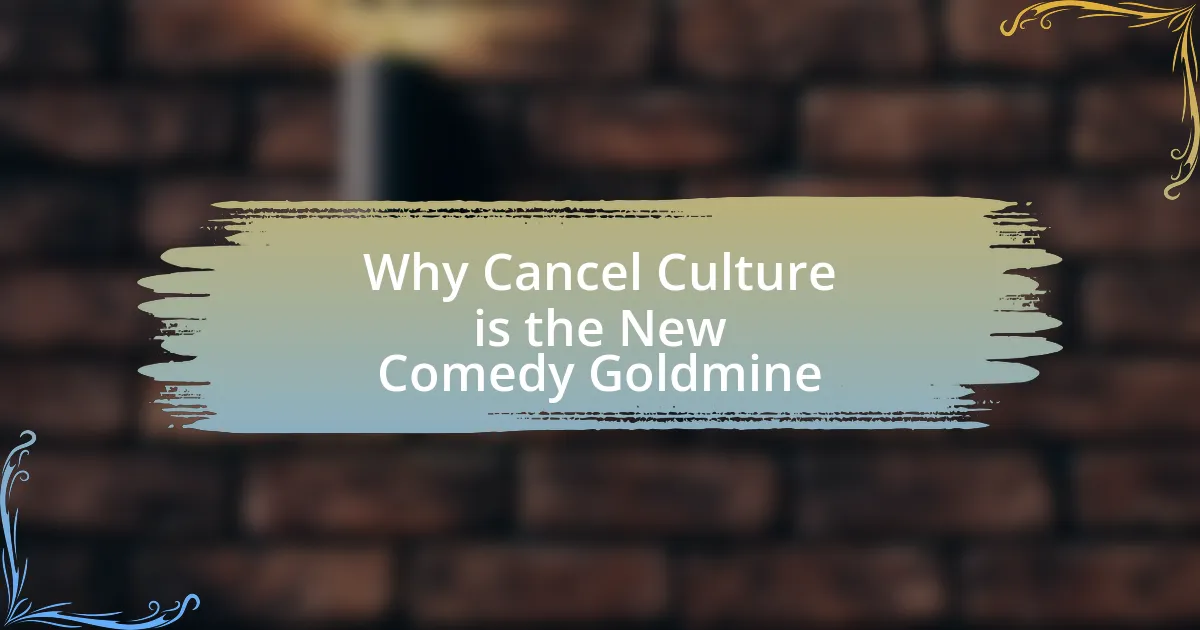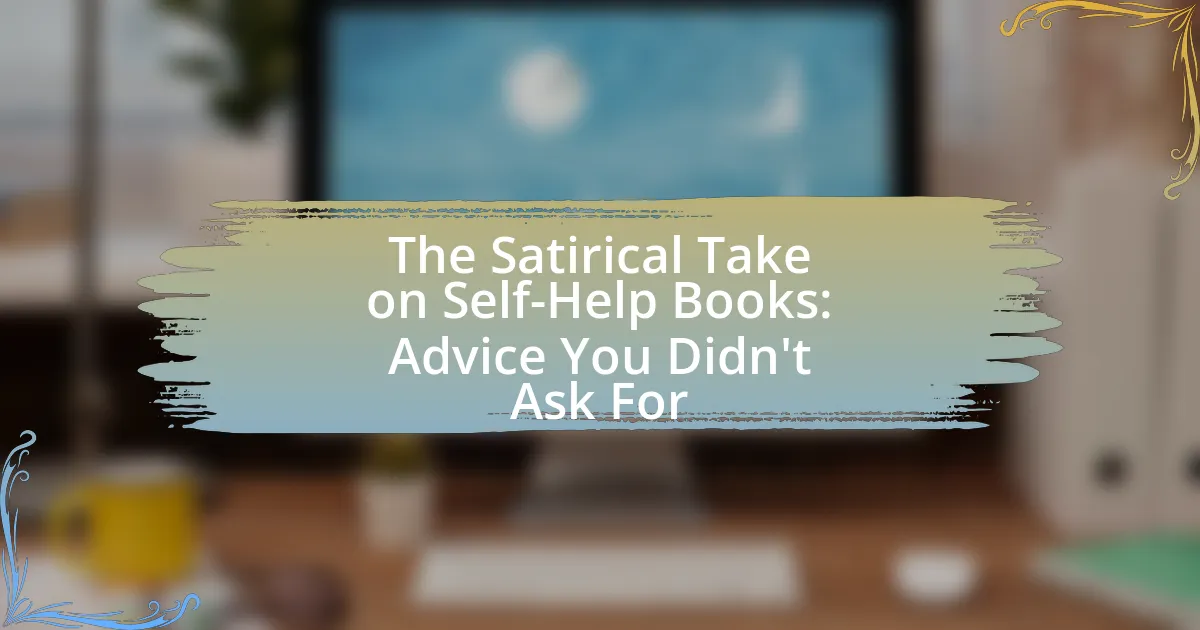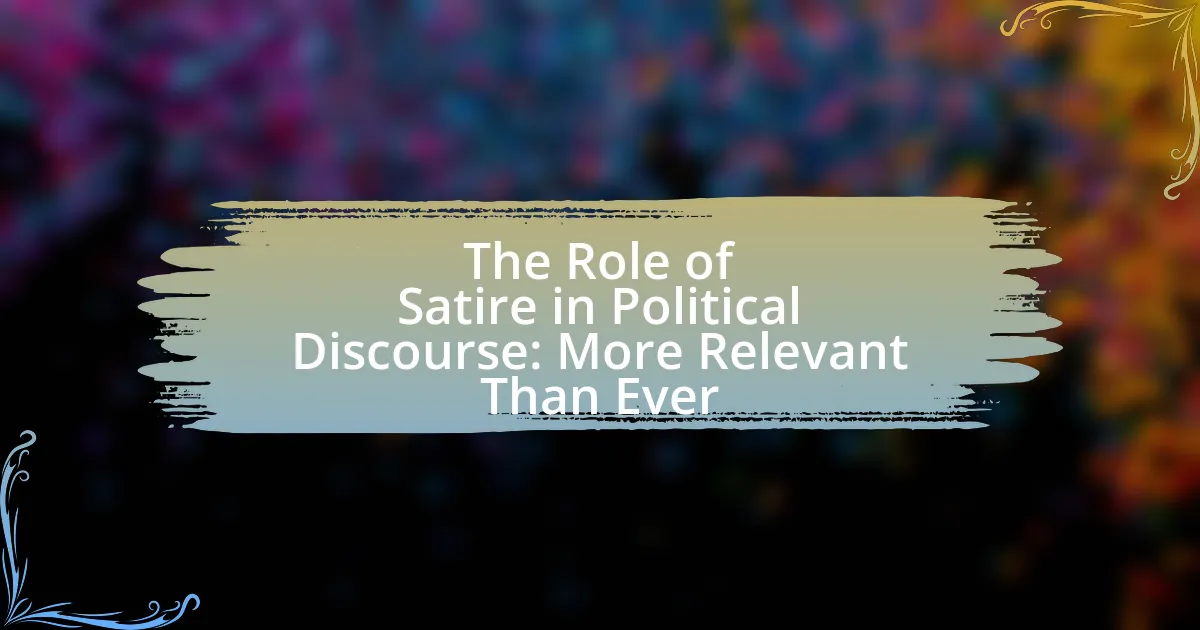Social media has emerged as a vital platform for satirical commentary, allowing users to humorously critique societal issues and engage in political discourse. The article explores how social media facilitates the rapid dissemination of satire through various formats like memes and videos, and highlights its role in shaping public opinion and awareness. It examines the evolution of satire on platforms such as Twitter and Facebook, the characteristics of satirical content, and the challenges associated with misinterpretation and backlash. Additionally, it discusses best practices for creating impactful satire while promoting responsible engagement among audiences.
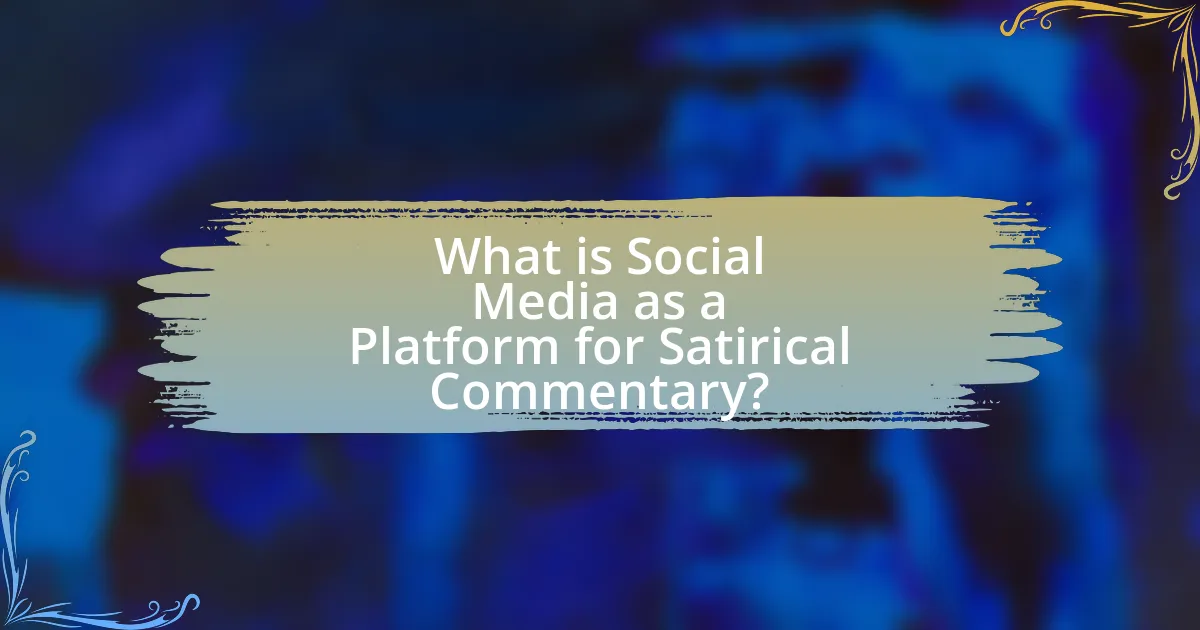
What is Social Media as a Platform for Satirical Commentary?
Social media serves as a dynamic platform for satirical commentary, enabling users to express humor and critique societal issues in real-time. This platform allows for the rapid dissemination of satirical content, often through memes, videos, and posts that can reach a wide audience instantly. The interactive nature of social media encourages engagement, allowing users to share, comment, and remix satirical material, which amplifies its reach and impact. Research indicates that platforms like Twitter and Facebook have become essential for political satire, with studies showing that satirical content can influence public opinion and political discourse. For instance, a study by the Pew Research Center found that 55% of social media users engage with satirical content, highlighting its significance in shaping contemporary conversations around politics and culture.
How has social media evolved as a space for satire?
Social media has evolved into a prominent space for satire by providing platforms that facilitate rapid dissemination and engagement with satirical content. Initially, traditional media outlets dominated satire, but the rise of platforms like Twitter, Facebook, and Instagram has democratized the creation and sharing of satirical commentary, allowing individuals and small groups to reach vast audiences. For instance, the use of memes and short videos has become a popular format for satire, enabling creators to convey complex ideas humorously and succinctly. According to a study by the Pew Research Center, 69% of adults in the U.S. use social media, which amplifies the reach of satirical content and fosters community engagement around shared humor. This evolution reflects a shift from passive consumption of satire to active participation, where audiences can interact, remix, and contribute to the satirical discourse.
What historical events influenced the rise of satirical commentary on social media?
The rise of satirical commentary on social media has been significantly influenced by events such as the advent of the internet in the late 20th century, the 2008 financial crisis, and the political polarization seen in recent elections. The internet’s expansion allowed for rapid dissemination of information and diverse viewpoints, fostering a culture where satire could thrive. The 2008 financial crisis led to widespread discontent and distrust in institutions, prompting satirical responses that critiqued economic policies and corporate behavior. Additionally, the political polarization during elections, particularly in the United States, has created a fertile ground for satirical commentary as individuals seek to express dissent and critique opposing viewpoints through humor. These events collectively shaped the landscape of social media, enabling satire to flourish as a form of commentary and engagement.
How do different social media platforms facilitate satire?
Different social media platforms facilitate satire by providing unique features that enhance the creation and dissemination of satirical content. Twitter, for example, allows for concise, rapid-fire commentary through its character limit, enabling users to craft sharp, witty remarks that can quickly go viral. Facebook supports longer posts and multimedia sharing, allowing satirists to create more elaborate narratives and visual satire, which can engage audiences on a deeper level. Instagram focuses on visual content, enabling satirical memes and images to spread rapidly, leveraging humor through visuals that resonate with users. TikTok’s short video format encourages creative and humorous interpretations of current events, allowing for satire to be presented in an entertaining and easily digestible manner. These platforms collectively create an environment where satire can thrive, as they facilitate quick sharing, audience engagement, and diverse content formats, making it easier for satirical commentary to reach a wide audience.
Why is satire important in social media discourse?
Satire is important in social media discourse because it serves as a powerful tool for critiquing societal norms and political issues. By using humor and exaggeration, satire can effectively highlight absurdities and injustices that might otherwise go unnoticed. For instance, satirical content often goes viral, reaching a wide audience and prompting discussions that can lead to greater awareness and social change. Research indicates that satirical news can influence public opinion and increase engagement with political topics, as seen in studies by the Pew Research Center, which found that individuals exposed to satirical content are more likely to discuss political issues online.
What role does satire play in shaping public opinion?
Satire plays a significant role in shaping public opinion by critiquing societal norms and political issues through humor and exaggeration. This form of commentary engages audiences, prompting them to reflect on serious topics while entertaining them. For instance, satirical programs like “The Daily Show” and “Saturday Night Live” have influenced public perceptions of political figures and events, often swaying opinions by highlighting absurdities in policies or behaviors. Research indicates that exposure to satirical content can increase political awareness and motivate civic engagement, as seen in studies published in the Journal of Communication, which demonstrate that satire can effectively inform and mobilize audiences.
How does satire contribute to political and social awareness?
Satire contributes to political and social awareness by using humor and irony to critique societal norms and political actions. This form of commentary engages audiences, prompting them to reflect on issues that may otherwise be overlooked. For instance, satirical programs like “The Daily Show” and “Saturday Night Live” have historically highlighted political scandals and social injustices, making complex topics more accessible and stimulating public discourse. Research indicates that exposure to satirical content can increase political knowledge and encourage civic engagement, as viewers often seek to understand the underlying issues being satirized.
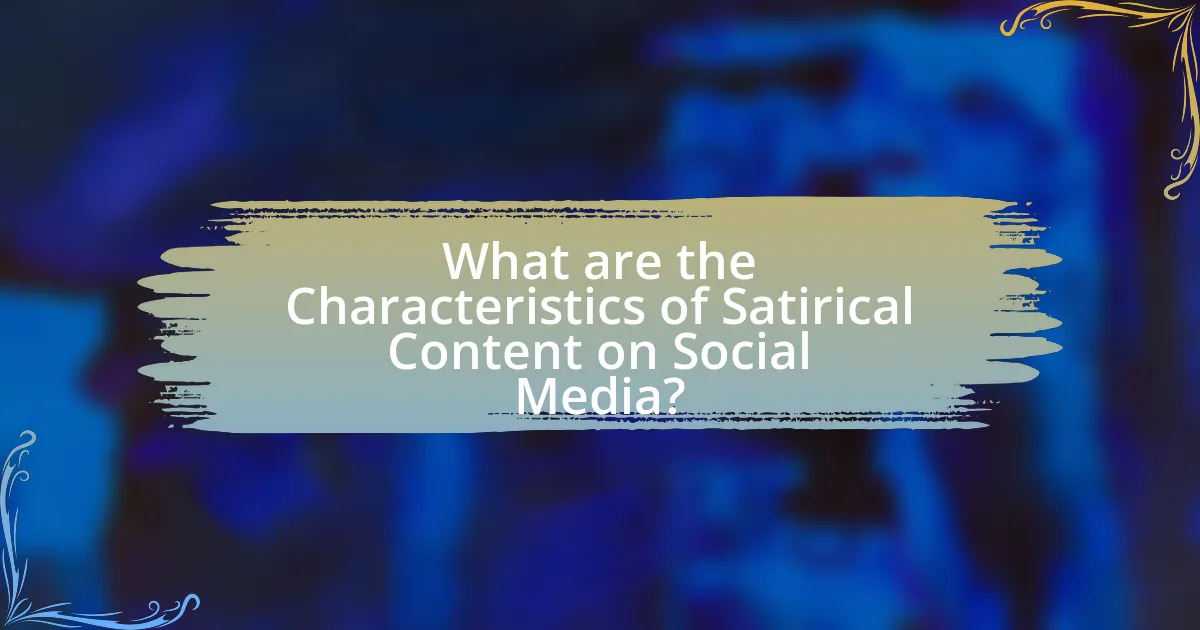
What are the Characteristics of Satirical Content on Social Media?
Satirical content on social media is characterized by humor, exaggeration, and irony, often targeting societal norms, political figures, or current events. This type of content employs wit to provoke thought and critique, using formats such as memes, parody accounts, and satirical articles. For instance, platforms like Twitter and Instagram frequently showcase satirical memes that highlight absurdities in politics, effectively engaging audiences through relatable humor. Research indicates that satirical content can enhance public discourse by encouraging critical thinking and fostering discussions around important issues, as seen in studies analyzing the impact of satirical news on audience perceptions.
What types of satire are commonly found on social media?
Common types of satire found on social media include parody, irony, and exaggeration. Parody mimics the style of a particular genre or individual to critique or mock, often seen in humorous videos or memes. Irony highlights the contrast between expectations and reality, frequently used in posts that reveal absurdities in societal norms or behaviors. Exaggeration amplifies certain traits or situations to absurd levels, making them more noticeable and often humorous. These forms of satire thrive on platforms like Twitter, Instagram, and TikTok, where brevity and visual elements enhance their impact and shareability.
How do memes serve as a form of satirical commentary?
Memes serve as a form of satirical commentary by using humor and visual elements to critique societal norms, politics, and cultural phenomena. This medium allows creators to convey complex ideas quickly and effectively, often exaggerating or distorting reality to highlight absurdities. For example, political memes can simplify intricate issues, making them accessible and relatable to a broader audience, thereby fostering critical discussions. Research indicates that memes can influence public opinion and shape discourse, as seen in the 2016 U.S. presidential election, where memes played a significant role in political engagement and satire.
What are the differences between parody and satire in social media?
Parody and satire in social media differ primarily in their intent and execution. Parody imitates a specific work or style to create humor, often exaggerating characteristics for comedic effect, while satire critiques societal norms, politics, or behaviors through humor, irony, or ridicule to provoke thought or change. For example, a parody might mimic a popular song to create a humorous version, whereas satire might use that same song to comment on a political issue, highlighting absurdities in a serious manner. This distinction is crucial as parody focuses on entertainment, while satire aims to inspire reflection and critique.
How do audiences engage with satirical content?
Audiences engage with satirical content primarily through sharing, commenting, and creating discussions on social media platforms. This engagement is driven by the humorous and critical nature of satire, which resonates with users’ experiences and opinions on societal issues. Research indicates that satirical content often prompts users to reflect on real-world events, leading to increased interaction; for example, a study by the Pew Research Center found that 55% of social media users share satirical content to express their views on political matters. This sharing behavior amplifies the reach of satire, fostering community dialogue and reinforcing shared beliefs among audiences.
What factors influence the shareability of satirical posts?
The shareability of satirical posts is influenced by factors such as humor, relatability, timeliness, and emotional resonance. Humor is essential, as posts that effectively use wit or irony tend to engage audiences more, leading to higher shares. Relatability plays a crucial role; when audiences can see themselves or their experiences reflected in the satire, they are more likely to share it. Timeliness is also significant; posts that comment on current events or trends resonate better and are more likely to be shared. Emotional resonance, including evoking laughter or outrage, can drive users to share content that elicits a strong reaction. Research indicates that content that combines these elements is more likely to go viral, as evidenced by studies showing that humorous and timely posts receive significantly more engagement on platforms like Twitter and Facebook.
How do audience demographics affect the reception of satire?
Audience demographics significantly influence the reception of satire by shaping individuals’ cultural backgrounds, values, and experiences. For instance, younger audiences may be more receptive to internet-based satire that employs memes and social media references, while older demographics might prefer traditional forms of satire, such as political cartoons or television shows. Research indicates that political affiliation also plays a crucial role; individuals with similar political beliefs to the satire are more likely to appreciate and engage with it, as shown in studies like “The Role of Political Identity in the Reception of Satire” by researchers at the University of Pennsylvania. Additionally, factors such as education level and socioeconomic status can affect comprehension and appreciation of nuanced satire, as those with higher education may better understand complex references. Thus, audience demographics create a framework that determines how satire is interpreted and valued.
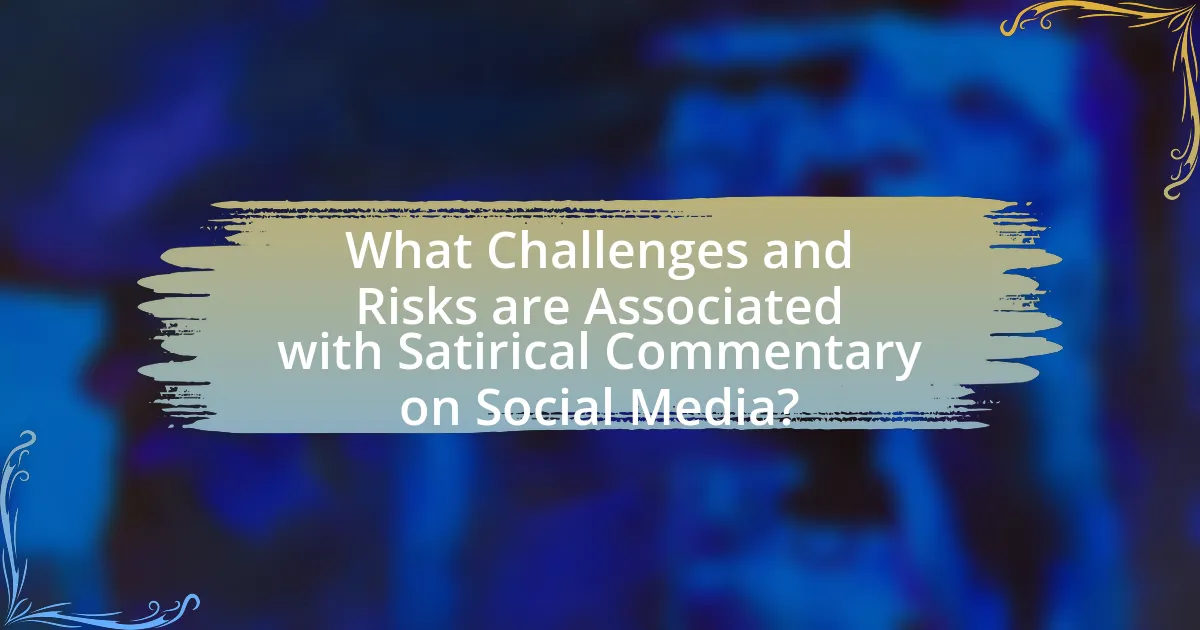
What Challenges and Risks are Associated with Satirical Commentary on Social Media?
Satirical commentary on social media faces several challenges and risks, including misinterpretation, backlash, and legal repercussions. Misinterpretation occurs when audiences fail to recognize satire, leading to confusion or offense; for instance, a 2020 study by the Pew Research Center found that 64% of social media users have encountered content they believed was satire but were unsure of its intent. Backlash can arise from individuals or groups who feel targeted or insulted, potentially resulting in online harassment or campaigns against the satirist. Legal repercussions may include defamation claims or copyright issues, as seen in cases where satirical content has led to lawsuits, highlighting the precarious balance between free expression and legal boundaries.
What are the potential consequences of satirical content?
Satirical content can lead to various consequences, including social awareness, polarization, and backlash. Social awareness is often heightened as satire can effectively highlight societal issues, prompting discussions and reflections among audiences. For instance, satirical shows like “The Daily Show” have been credited with increasing political engagement among viewers. However, polarization can occur when satire is misinterpreted or taken too seriously, leading to divisions among different groups. Additionally, backlash may arise from individuals or entities who feel targeted or offended by the satire, resulting in public disputes or calls for censorship. These consequences illustrate the complex impact of satirical content in social discourse.
How can satire lead to misinformation or misunderstanding?
Satire can lead to misinformation or misunderstanding by presenting exaggerated or distorted versions of reality that audiences may interpret as factual. This occurs because satire often employs humor and irony, which can obscure the underlying truth and mislead viewers who may not recognize the satirical intent. For instance, a study published in the journal “Communication Research” found that individuals who consume satirical content without critical thinking are more likely to accept false information as true, particularly when the satire aligns with their pre-existing beliefs. This blending of humor with serious topics can create confusion, leading audiences to misinterpret the satirical message as a legitimate commentary on real events.
What legal issues can arise from satirical commentary?
Satirical commentary can lead to legal issues such as defamation, copyright infringement, and violations of trademark law. Defamation occurs when a satirical piece falsely portrays an individual or entity in a way that damages their reputation; for example, the case of Hustler Magazine v. Falwell established that public figures must prove actual malice to win a defamation claim. Copyright infringement may arise if a satirical work uses protected material without permission, as seen in cases involving parodies of copyrighted works. Additionally, trademark law can be implicated if the satire causes confusion about the source of goods or services, which can lead to legal challenges from trademark holders. These legal issues highlight the complexities surrounding the balance between free expression and the rights of individuals and entities in the context of satire.
How do social media platforms regulate satirical content?
Social media platforms regulate satirical content primarily through community guidelines and content moderation policies. These platforms often categorize satirical content under misinformation or harmful content, leading to potential removal or labeling. For instance, Facebook and Twitter have specific policies that address misleading information, which can include satire that may be misinterpreted as factual. Additionally, platforms utilize algorithms and human moderators to assess the context and intent behind posts, determining whether they align with their standards. This regulation is evident in actions taken against accounts that repeatedly share satirical content deemed misleading, as seen in Twitter’s enforcement of its rules against misinformation during significant events like elections.
What guidelines do platforms have regarding satire and parody?
Platforms generally allow satire and parody under their content guidelines, provided that the content is clearly identifiable as such and does not violate other community standards. For instance, Facebook’s Community Standards state that content that is intended to be humorous or satirical is permitted, as long as it does not incite violence or hate speech. Similarly, Twitter’s rules allow parody accounts, but they must not mislead users about their identity or impersonate others in a harmful way. These guidelines are designed to balance freedom of expression with the need to prevent misinformation and harm.
How do users navigate platform policies when sharing satire?
Users navigate platform policies when sharing satire by carefully interpreting guidelines and adjusting their content to align with community standards. For instance, many social media platforms, such as Facebook and Twitter, have specific rules regarding hate speech, misinformation, and harassment, which users must consider to avoid content removal or account suspension. Research indicates that users often employ strategies like using disclaimers, context, or humor to clarify their intent, thereby reducing the risk of misinterpretation by both the platform and its audience. This approach is supported by the fact that platforms have faced criticism for inconsistent enforcement of policies, prompting users to be more cautious and strategic in their satirical expressions.
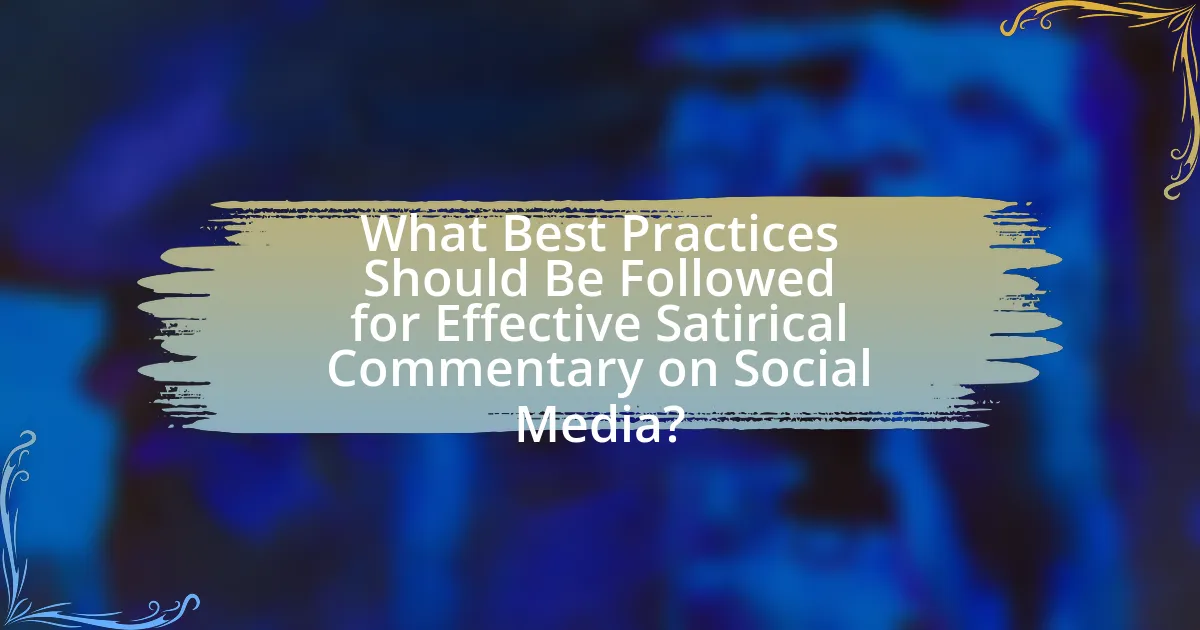
What Best Practices Should Be Followed for Effective Satirical Commentary on Social Media?
Effective satirical commentary on social media should prioritize clarity, relevance, and audience engagement. Clarity ensures that the satire is easily understood, which is crucial for conveying the intended message. Relevance to current events or social issues enhances the impact, as audiences are more likely to engage with content that resonates with their experiences or opinions. Engaging with the audience through humor and relatable content fosters interaction, encouraging shares and discussions.
Research indicates that satirical content that aligns with trending topics garners higher engagement rates, as seen in studies analyzing social media interactions during major political events. For instance, a study by the Pew Research Center found that satirical posts related to political events received significantly more shares and comments compared to unrelated content.
How can creators ensure their satire is impactful and responsible?
Creators can ensure their satire is impactful and responsible by grounding their work in factual accuracy and clear intent. By using well-researched information, creators can avoid spreading misinformation, which is crucial in a digital landscape where false narratives can quickly gain traction. Additionally, creators should consider their audience’s perspectives and potential sensitivities, as satire that alienates or offends can undermine its effectiveness. For instance, a study published in the Journal of Communication found that satire that aligns with the audience’s values is more likely to resonate and provoke thoughtful discussion. This approach not only enhances the impact of the satire but also fosters a sense of responsibility in addressing social issues without perpetuating harm.
What techniques enhance the effectiveness of satirical messages?
Techniques that enhance the effectiveness of satirical messages include exaggeration, irony, and juxtaposition. Exaggeration amplifies the absurdity of a situation, making it more recognizable and relatable to the audience. Irony creates a contrast between expectations and reality, prompting critical thinking about the subject matter. Juxtaposition places opposing ideas side by side, highlighting contradictions in societal norms or behaviors. These techniques are supported by studies indicating that humor, when effectively employed, increases audience engagement and retention of the message, as seen in research by the University of California, which found that satirical content can significantly influence public opinion and awareness.
How can creators avoid crossing ethical lines in satire?
Creators can avoid crossing ethical lines in satire by ensuring their work does not promote harm or misinformation. This involves being mindful of the potential impact of their satire on marginalized groups and avoiding stereotypes that can perpetuate discrimination. For instance, creators should focus on critiquing systems or behaviors rather than targeting individuals or vulnerable populations. Additionally, they can incorporate disclaimers to clarify the intent of their satire, which helps audiences understand the context and reduces the risk of misinterpretation. Research indicates that satire can be effective in social commentary when it fosters dialogue rather than division, as seen in studies by the Pew Research Center, which highlight the importance of responsible satire in shaping public discourse.
What tips can help users engage with satirical content responsibly?
To engage with satirical content responsibly, users should critically evaluate the source and context of the satire. This involves verifying the credibility of the platform and understanding the intent behind the satire, as misinformation can easily spread through social media. Research indicates that 64% of adults believe that satirical news can mislead audiences if not properly contextualized, highlighting the importance of discernment. Users should also differentiate between satire and genuine news, as this distinction is crucial for informed consumption. Engaging in discussions about the satire can further enhance understanding and promote responsible sharing.
How can audiences critically evaluate satirical posts?
Audiences can critically evaluate satirical posts by analyzing the intent, context, and factual accuracy of the content. Evaluating the intent involves understanding whether the post aims to entertain, provoke thought, or critique societal issues. Context is crucial; audiences should consider the cultural and political environment in which the satire was created, as this can influence its meaning. Additionally, checking the factual accuracy of claims made in the satirical post helps audiences discern between humor and misinformation. Research indicates that critical media literacy skills enhance the ability to differentiate satire from genuine news, thereby fostering a more informed audience capable of engaging with satirical content responsibly.
What strategies can users employ to promote healthy discourse around satire?
Users can promote healthy discourse around satire by encouraging critical thinking and fostering open dialogue. By sharing educational resources that explain the purpose and context of satire, users can help others understand its nuances. Additionally, users should model respectful engagement by addressing differing opinions constructively, which can lead to more meaningful conversations. Research indicates that platforms that prioritize user education and community guidelines see improved discourse quality, as seen in studies by the Pew Research Center on online interactions.



